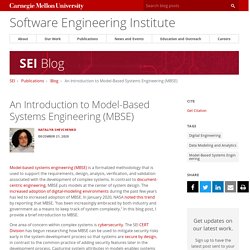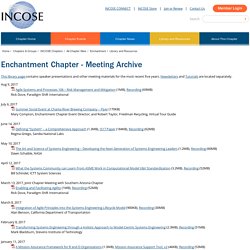

MITRE MOOSE Pilot. An Introduction to Model-Based Systems Engineering (MBSE) Model-based systems engineering (MBSE) is a formalized methodology that is used to support the requirements, design, analysis, verification, and validation associated with the development of complex systems.

In contrast to document-centric engineering, MBSE puts models at the center of system design. The increased adoption of digital-modeling environments during the past few years has led to increased adoption of MBSE. In January 2020, NASA noted this trend by reporting that MBSE, "has been increasingly embraced by both industry and government as a means to keep track of system complexity. " In this blog post, I provide a brief introduction to MBSE. Systems Engineering Advancement Research Initiative - SEAri at MIT. SEAri has published the following documents in journals, magazines, or conference proceedings.

Questions regarding content should be directed to the primary author of a given publication. 2020, 2019, 2018, 2017, 2016, 2015, 2014, 2013, 2012, 2011, 2010, 2009, 2008, 2007, 2006, pre-2006 Rhodes, D.H., "Investigation of Leading Indicators for Systems Engineering Effectiveness in Model-Centric Programs," 17th Annual Acquisition Research Symposium, Monterey, CA, May 2020. Rhodes, D.H., "Investigating Model Credibility within a Model Curation Context," 18th Conference on Systems Engineering Research, October 2020. Lorin/systems-thinking: Overview of different schools of systems thinking.
SERC – Systems Engineering Research Center. Karl Rehbinder – System Collaboration Blog Book. PPI SyEN 71: News in the Field of Systems Engineering. Advancing Participatory Narrative Methods of Inquiry. Systems Thinking Speech by Dr. Russell Ackoff. Broadcast Yourself. Strategic Engineering Research Group: Olivier L. de Weck. We are very interested in better understanding and deliberately designing lifecycle properties into systems.

Lifecycle properties are those characteristics of systems that are not the immediate functionality that is apparent when they are first turned "on", but their long-term properties such as how well they hold up over time (reliability, durability), how likely they are to fail and cause harm (safety, resilience), how easy they are to change if needed (flexibility, changeability, adaptability ...) and how well they work with others (interoperability). The following graphic shows the relationship of a set of 22 most common ilities to each other. The size of the nodes relates to the number of scientific papers written on each system property while the line weight indicates the strength of the diadic relationship.
Library and Resources. This library page contains speaker presentations and other meeting materials for the most recent five years.

Newsletters and Tutorials are located separately. Aug 9, 2017 Agile Systems and Processes 106 – Risk Management and Mitigation (1MB), Recording (69MB) Rick Dove, Paradigm Shift International. Praxis is a free framework for the management of projects, programmes and portfolios - Praxis Framework. SETR Process Handbook v1.0 20150206.